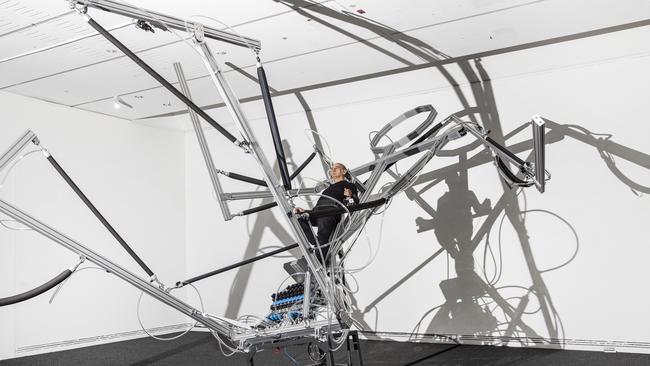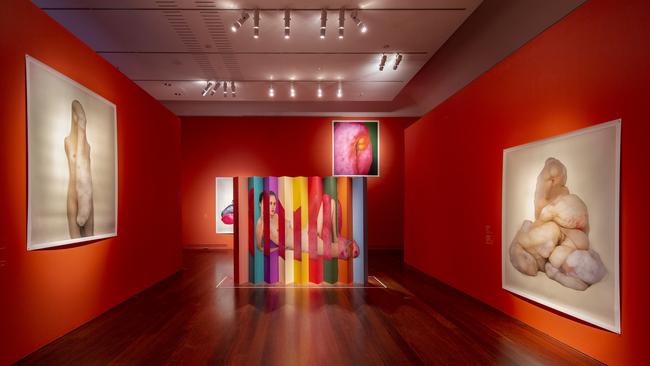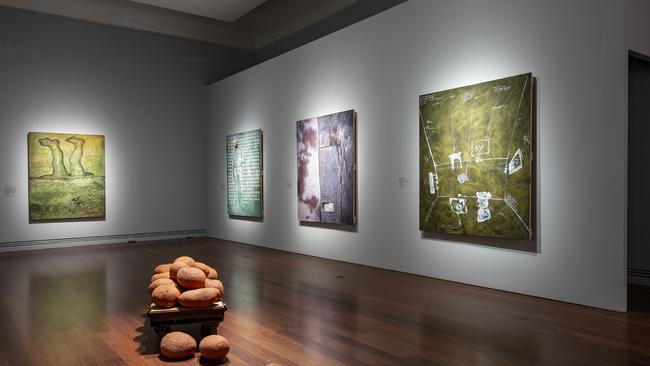Christopher Allen reviews, Adelaide Biennial of Australian Art: Monster Theatres
There are good things here if you have the time to find them.

Months have passed since I saw first this exhibition and drafted the review. I began it by observing that the coronavirus crisis was unfolding so quickly that the situation might well be much worse by the time the review appeared; in the event, the AGSA closed, so we held the piece. But on re-reading it, what follows seems more relevant than ever.
The exhibition is a snapshot of the complacent and inbred world of official contemporary art. The question is whether, after an enforced break which has allowed us to ponder how little we miss this kind of exhibition, we will settle back into the same mediocrity sustained by institutions, misdirected arts funding and a speculative art market.
It’s not that art is less important in times of crisis such as war or pandemic; perhaps it is more important in reminding us about ultimate realities of our common humanity, of the beauty of the world and of spiritual insight. But it is only the best art, literature and music that embody these things. This is no time for the second-rate and the trivial.
Nor is it a time for the ersatz politics favoured by the contemporary art world – a mishmash of gender and postcolonial pieties that essentially serves to flatter the moral self-satisfaction of its audience. So-called identity politics in particular, the substitute for real political awareness in a fragmented world, is fundamentally collective narcissism; and as we see time and again, narcissism is a bottomless vortex of self-pity.
In fairness, although the first impression of the Adelaide Biennial of Australian Art was underwhelming, visiting this year’s dismal Sydney Biennale a week later made the Adelaide exhibition feel a bit more coherent and impressive by comparison.
Two associated exhibitions in Adelaide, one at the Samstag Museum and the other a small exhibition of historical prints at the Art Gallery of South Australia, may also be reviewed separately.
As for the main exhibition, you walk downstairs into the basement to be confronted by a space full of rooftops. The artist has taken a lot of trouble, and no doubt spent quite a bit of money, but the result is opaque to say the least. You can consult statements by artists and curators to find out what things are alleged to mean, but meaning is either inherent in a work or not. Can you imagine reading an unintelligible poem and then being asked to look at the poet’s statement to find out what he intended?
One of the more striking pieces in the exhibition is a short film by Erin Coates and Anna Nazzari, although as I have observed before, I have hardly ever seen an audience member stay in a video work like this long enough to understand what was going on. And this is not merely because audiences are lazy and have a short attention span, although that is part of the problem.
It is actually even more serious than that: it seems that they have lost the habit of giving an artwork the time it inherently demands to be understood. Kenneth Clark replied, when asked how long one should look at a painting, about the time it takes to peel and eat an orange. For a time-based work, it can be a lot longer.
But audiences seem to feel that the main point is to experience a brief moment of surprise, like a small jolt out of the blur of an unconscious existence. They don’t engage with the work long enough to understand what it was about, or to be provoked into any kind of independent reflection. That’s probably why some of them like the quasi-political works, because they can instantly recognise an ideological commonplace and feel validated by approving of it, just as they will predictably like a post on Facebook.
The film, as it becomes clear to anyone who actually watches it, is a surreal and gruesomely fantastic story about a young woman whose mother has just died after suffering multiple sclerosis for many years. Her house is to be sold and the young woman is sorting and clearing out her mother’s clothes and other effects. She mourns, she remembers, she drinks wine and at one point lies on the couch to masturbate until she is interrupted by a horrible and mysterious event.
In the middle of all this she finds a box containing ultrasounds which show that her mother was originally pregnant with twins. There is a horrible (and in fact impossible) suggestion that one of the foetuses may have consumed the other, but this hint is made in passing as the ultimate explanation for what happens next, when she descends into the flooded basement of the unconscious mind and makes a ghastly discovery.
Shown with the film are a number of other items by the two artists who have collaborated in its making, including ink drawings in scrimshaw on whale teeth and a series of images – more directly related to the imaginative world of the film – in which the inner organs of bodies merge into shells and molluscs, recalling James Gleeson’s surrealist paintings of the 1980s and 90s.
Another of the more impressive works is a huge room by Judith Wright crowded with imaginative and idiosyncratic figures that evoke dreams and nightmares. What makes this so effective is the clever use of found objects like mannequins and store dummies, combined with deliberately artificial and non-illusionistic elements, like a tiger made of flat sheets of plywood. Real found objects bring their freight of metaphoric and metonymic associations and are then interfered with in unexpected and disturbing ways, like a crowd of shoe blocks on which eyes have been painted. A sentimental store dummy of a child becomes Cupid with makeshift wings; two other dummies become angels standing over a Christ child from a nativity scene; and all of this is made more mysterious and disturbing by shadows the objects cast on the walls all around.
Why a work like this is evocative is that it finds a way to touch our imagination, to evoke memories, speak to longings and fears, and leaves us a little more aware of how much goes on in our minds beyond the light of reason. In contrast, the reason that Karla Dickens’s work is so boring is that it is a jumble of completely predictable motifs, mixing a disagreeable cocktail of resentment and smugness.
Another work that is undeniably striking is Stelarc’s huge robotic figure, which the artist can sit in and operate like an extension of his own body. In his absence, visitors can move the limbs of this mechanical man by pressing a set of buttons on a control panel. Stelarc has been doing prosthetic limbs and body extensions like this for decades; they are intriguing like any kind of big toy, but it doesn’t go much further than that.
A number of works seem to be about the perennial theme of physical and psychic self-loathing, as in the works of Polly Borland, where bodies disappear into amorphous masses, or those of Brent Harris which again evoke disgust and a kind of horror at the reality of the body. Similar themes are evoked in a series of videos of Mike Parr’s most famous performances.

It’s curious to ponder where this quasi-Christian sense of the body as vile has come from. But perhaps the answer is rather in recalling what the idealisation of the body, which begins with the Greeks, meant in the first place. The beautiful body was not, as we may imagine, just an expression of erotic admiration: it was ultimately the metaphor of the dignity of man, of what we call humanism.
Humanism is essentially a confidence in the ability of human beings to understand and manage their own lives – as opposed to trusting in the pronouncements of a witchdoctor or obeying the orders of a tyrant. Today we seem to be less religious than ever, and we believe we live in democratic states. So why are we so unhappy with the human body?
In reality, however, a number of new ideas in the 19th century, from those of Darwin or Marx to those of Freud and others, subtly undermined some of the assumptions of humanism, suggesting we were at the mercy of impersonal and irrational forces both in the natural and social world around us, and even inside our minds. The development of mass societies, mass media and now mass social media have aggravated our sense of disorientation.
This is the sort of anxiety, no doubt, that lies behind the work that the Biennial has used in its promotion, but which falls extraordinarily flat in reality. A monkey in human clothes and a cap sits in a row of seats, staring at an empty stage with a microphone, as though waiting for a speaker or singer to appear, and a vivid red curtain behind.
Almost incredibly, we are told Abdul Abdullah’s Understudy is meant to make us ponder an endangered monkey species. It is assumed that we will recognise the brands of the clothing the figure is wearing. But once again an enormous amount of trouble has been taken for a work that has little or no meaning in itself.

And yet again, this doesn’t seem to matter, because those in the know will repeat what the text asserts, while the mass of the visitors – if one can speak of numbers at all when the galleries are nearly deserted – will be content with that micro-jolt of surprise and proceed on their way without feeling the need to find out what the work was supposed to signify, or perhaps worse still assuming that nothing ultimately has any meaning.
Most striking is the contrast between the passive indifference of the audience and the conviction or at least the assertion by artists and curators that their work is charged with social and political significance.
The paintings and sculptural objects of Aldo Iacobelli are notable illustrations of the principle. A series of paintings present more or less obscure and gratuitous images; one is a long commentary in Italian on American forces stationed in Naples at the end of WWII and complaining that they frequented the brothels, drank a lot of beer and then pissed promiscuously against the walls of the city.

This and other images are declared in one of the labels to be part of a “critique of global power structures”. Now of course this is just the kind of vacuous formula which taps itself, the brain switched off, on the keyboard of a contemporary art curator.
But if we even pretend to take it seriously for a moment, what can it possibly mean?
Adelaide Biennial of Australian Art: Monster Theatres, Art Gallery of South Australia, until August 2.


To join the conversation, please log in. Don't have an account? Register
Join the conversation, you are commenting as Logout